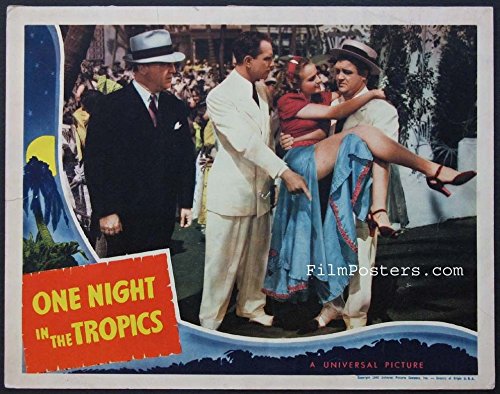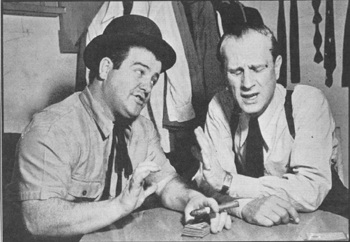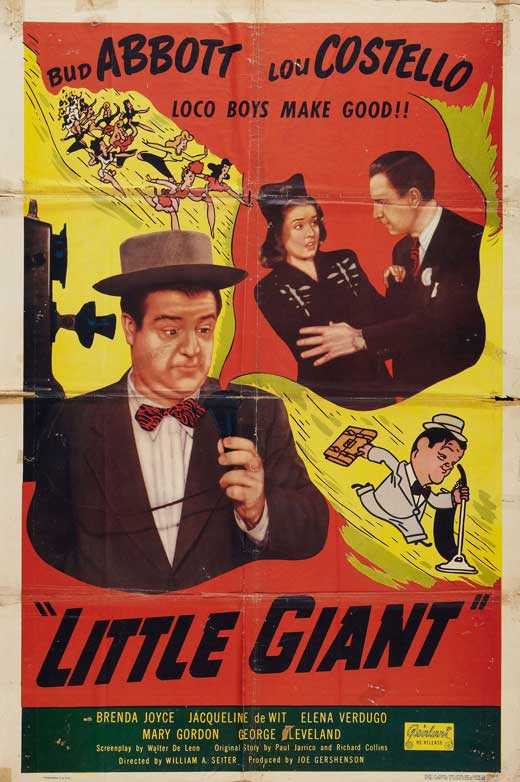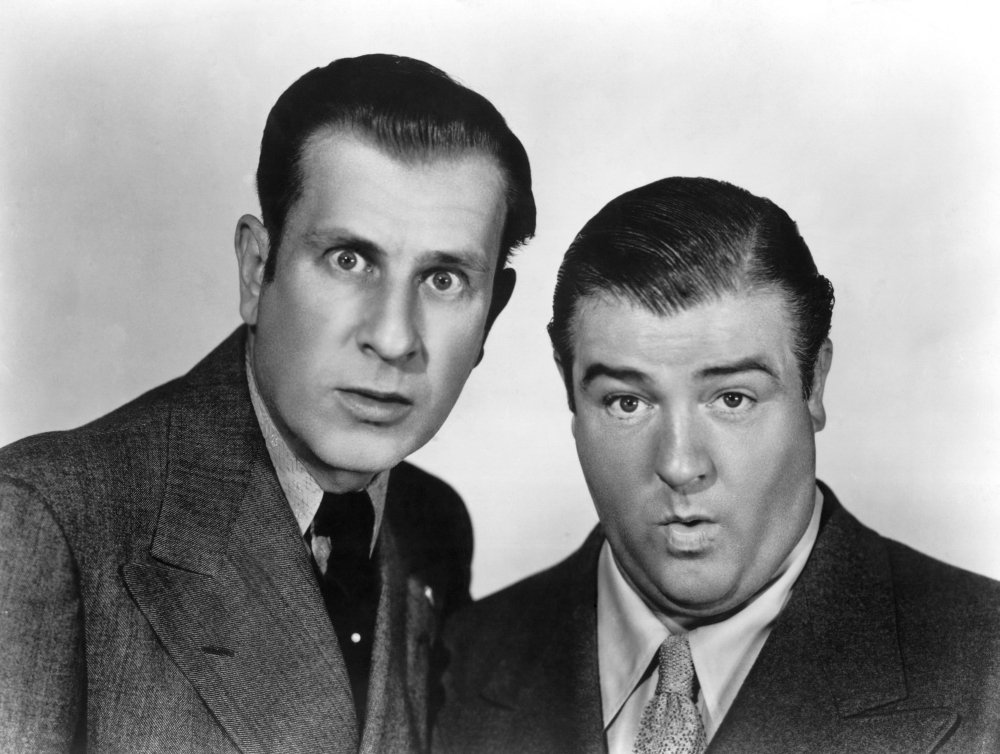Lou Costello (March 6, 1906 – March 3, 1959)
Lou Costello, the man who would ask the eternal question, Who’s on First?, was born as Louis Francis Cristillo on March 6, 1906. He grew up in his hometown of Patterson, New Jersey, which he mentioned in virtually every movie and television episode that he appeared in. After high school, he had been bitten by the entertainer bug, and worked as a carpenter at both MGM and Warner Brothers movie studios in an attempt to break into show business
. He appeared as an extra in several films from 1926 through 1928, most noticeably in Laurel and Hardy’s Battle of the Century — the most celebrated pie fight movie ever filmed. After several years of no success, Lou left Hollywood and began working the vaudeville circuit on his way back home to Patterson, New Jersey.
However, the desire to entertain grew stronger and Lou started working in vaudeville, gaining valuable experience over the years, learning comedic timing, character, pacing, and how to present a clean show in the bawdy venues. As did most comedians of the time, he typically worked with a straight man — someone who would set up the jokes, and work to rein in the comedian when he was going too far, or starting to lose the audience. According to Lou, one night in 1931 his normal straight man had taken ill. He asked the theater manager, who also worked as a straight man, to fill in. Bud Abbott agreed, creating the birth of one of the greatest comedy teams of all time.
Lou Costello’s years in vaudeville continued to be lean, even with his new partner and the act’s increased popularity. Even so, Lou married Ann Battlers, whom he had met while performing. Abbott and Costello had a large break in 1938, gaining their first national exposure on Kate Smith’s weekly radio show. They soon started to gain the notice of power players in the entertainment industry, and in 1939 Lou signed a contract with Universal Pictures. The next year, Bud and Lou filmed One Night in the Tropics. Originally, they had small roles in the film, but as they were filming their roles were enlarged time and again, as the film crew kept breaking up in laughter during the filming of Abbott and Costello’s scenes. In this movie, they introduced several of their signature routines, including an abbreviated version of Who’s on First? and A Dollar a Day (where Abbott has hired Costello for the sum of $1.00 per day for the last year, and now that it’s time to pay up, finds exception after excuse to pay him less and less, ending with $1.00 for the entire year – classic, and truly funny). In his personal life, his daughter Carole was born.
The next year, Bud Abbott and Lou Costello starred in Buck Privates, which became a major hit, grossing over $10,000,000.00 — bear in mind, at this time a movie ticket cost $0.25. Financially, Buck Privates did better than Citizen Kane. Swiftly following that same year came In the Navy, Keep ‘Em Flying and Hold That Ghost. All of these were large successes, and propelled Lou to stardom, with all of the financial rewards that included. In that same year of 1941, Bud and Lou began their weekly radio show, “The Abbott and Costello Show” on the ABC radio network, which ran until 1946. Also, his private life was changing, as his son, Lou Jr., was born.
The next year, 1942, was a year of triumph for Lou Costello. His radio and film career continued, releasing the movies Who Done It?, Pardon My Sarong, Rio Rita and Ride ’em Cowboy — all of which were box office hits.
The next year, 1943, was life-changing for Lou Costello in many ways. In addition to filming It Ain’t Hay, he and Bud Abbott used their immense popularity to raise money for the war effort. They began a cross-country tour, at their own expense, to raise funds on behalf of the War Bond Drive. They were honored on the steps of New York’s City Hall by Mayor Furiello LaGuardia for raising a record-breaking 89 million dollars in just three days and continued raising money throughout the year. After completing filming on Hit The Ice, they continued fundraising — with disastrous health results for Lou. Lou Costello contracted Rheumatic fever, resulting in heart damage that led years later to his death. It also prevented him from working for over a year. On the same day that Lou Costello was to return to the air, tragedy struck again as Lou Costello’s son, Lou Jr., died in a tragic drowning accident just days before his first birthday. This was a blow from which Lou never fully recovered, making him a more bitter individual. However, he remained first and foremost a performer. On the day of his son’s death, he insisted on performing on their live radio show.
Two incidents that happened during the shooting of Hit the Ice serve to illustrate some of the characteristics that Lou had developed. The film was started by director Erle C. Kenton, but he and Lou clashed on several occasions, and Kenton was fired and replaced by Charles Lamont. Lou tended to become more and more demanding and rebellious as time went on. A more humorous anecdote is that Lou suspected that Universal wasn’t giving him and Bud Abbott the agreed-upon share of the profits made by their films (a suspicion later proven, in legal action they took against Universal). In retaliation, he developed a habit of picking out furniture he liked from the sets of their films and taking it home. One day director Charles Lamont showed up on the set to shoot a scene at the ice skating rink only to discover that all the wrought-iron patio furniture that had been there the previous day had disappeared. Lou denied any knowledge of it, and Lamont said he would shoot no more scenes until the furniture was returned. A compromise was finally reached where Lou would bring back the furniture, the scene would be shot, and then he would be allowed to bring all of the furniture back home.
In 1944, Lou Costello was having contract renegotiation difficulties with Universal Pictures. As a result, during the filming of In Society, Bud and Lou refused to do re-shoots and every day, at exactly 4:00 p.m., whether they were in the middle of a scene or in the middle of a line, would immediately cease working and go home. Interestingly enough, this led to the practice of shooting a scene from multiple angles with multiple cameras, which has since become common practice. Eventually, new contracts were signed, and Bud and Lou went on to make Lost in a Harem, and in 1945 Abbott and Costello in Hollywood, Here Come the Co-Eds and The Naughty Nineties (containing the definitive version of their famous Who’s on First? routine)
In 1946, Bud Abbott and Lou Costello moved their weekly radio show, “The Abbott and Costello Show” to the NBC network, where it remained through 1949, but other than that the show remained unchanged. In that same year, they produced two of their most outstanding films, Little Giant and The Time of their Lives. Both deviated from their standard formula, and both gave Lou room to truly bloom as a dramatic actor, as well as a clown and comedian. Neither, however, did well at the box office, despite being excellent films. They were simply too different from what the public was expecting from Abbott and Costello.
In 1947, Lou Costello returned to his standard movie formula, with Buck Privates Come Home (a sequel to their first blockbuster hit, Buck Privates). During the filming of the western The Wistful Widow of Wagon Gap that same year, Lou Costello’s father died. He was a western film buff, and as a tribute Lou listed him in the credits as Associate Producer, Sebastian Cristillo. The next year continued in the same way with The Noose Hangs High and Mexican Hayride — until their final movie of 1948, which changed the direction of Lou’s career — Bud Abbott and Lou Costello Meet Frankenstein. A large financial hit, and leading to a bevy of movies following the same formula — Abbott and Costello Meet the Killer, Boris Karloff (1949), Abbott and Costello Meet The Invisible Man (1951), Abbott and Costello Meet Captain Kidd (1952), Abbott and Costello Meet Dr. Jekyll and Mr. Hyde (1953), Abbott and Costello Meet the Keystone Cops (1955), Abbott and Costello Meet the Mummy (1955).
In addition to the “Abbott and Costello Meet …” formula, Lou Costello continued making other films with his partner, including Abbott and Costello in the Foreign Legion (1950), Comin’ Round the Mountain (1951), Lost in Alaska(1952), Abbott and Costello Go to Mars (1953), Jack And The Beanstalk(1952), and Dance with Me, Henry (1956). Although still popular, Lou’s movie career seemed to be winding down. However, television greeted Lou with open arms with The Abbott and Costello Show (1952-1954), reusing many of the most popular movie routines on their weekly TV series. In addition, the television series was produced by Television Corporation of America production company, owned by Lou.
In 1956, one year before the release of their last film together, Bud and Lou were brought together on The Steve Allen Show before a live nationwide viewing audience. The emotion was further heightened when Steve Allen announced the induction of Abbott and Costello and their Gold Record of Who’s On First into the World-famous, Baseball Hall of Fame in Cooperstown, N.Y. Abbott and Costello are the first (and only, to date) non-baseball playing celebrities ever to be inducted into the Baseball Hall of Fame.
Over these same years, Lou Costello’s off-screen relationship with his long-time partner Bud Abbott became more and more strained, leading to an eventual dissolving of their partnership in 1957. In that same year, both Bud and Lou became officially bankrupt, after tax issues with the IRS. In 1959, he filmed his first solo film, The 30 Foot Bride of Candy Rock, but he died of heart problems before it was released. Many people have famous last words — Lou’s final words were, “That was the best ice cream soda I ever tasted.”
In 1994, Lou Costello’s hometown of Patterson, New Jersey erected a life-size bronze statue of Lou holding a bat, wearing his trademark derby, placed in a city park.
Quotes by Lou Costello:
- Comics are a dime a dozen. Good straight men are hard to find.
- (from One Night in the Tropics) Costello lights up a cigar
Abbott : Put that out there’s no smoking in here.
Costello : What makes you think I’m smokin’?
Abbott : You’ve got a cigar in your mouth!
Costello : I’ve got shoes on, don’t mean I’m walkin’. - Costello : He’s gonna make a wonderful husband.
Abbott : You don’t even know what a husband is.
Costello : A husband is what’s left of a sweetheart after the nerve has been killed.
Other Resources for Lou Costello
- The official Abbott and Costello website, www.abbottandcostello.net
- Lou’s on First, the loving biography of Lou Costello by his daughter Chris Costello
Article by Tom Raymond of Famous Clowns - the definitive source for clowns of all ages.






